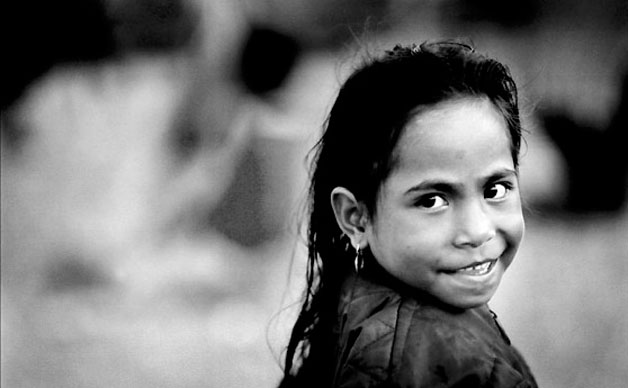
Between 1975 and 1999, some 200,000 Timorese were killed by Indonesian occupation forces who used starvation and sexual violence alongside chemical weapons and napalm. In 1999, a long-awaited independence referendum brought renewed violence, as Indonesian military and paramilitary reprisals killed over 2,000 Timorese and decimated 75% of the country’s infrastructure. Some 240,000 persons—one third of the population—fled their homes and were forcibly relocated to the Indonesian province of West Timor.[1] Today, an independent Timor-Leste is undertaking a courageous project of transitional justice.
Population & History
The first new sovereign state of the 21st century, Timor-Leste occupies the eastern half of the island of Timor in the Indonesian archipelago. With an area slightly larger than Maryland, Timor-Leste is home to a population of 1.1 million, comprising Malayo-Polynesian and Papuan communities and a small Chinese minority. From 1702 to 1975, Timor-Leste was a colony of Portugal.
Indonesian Occupation: 1975-1999
On November 28, 1975, Timor-Leste declared independence from Portugal. The power vacuum that followed the Portuguese withdrawal was largely filled by the grassroots pro-Independence party, Fretilin (The Revolutionary Front of Independent East Timor), who assumed a quasi-governmental role.
To the United States, which had recently withdrawn from South Vietnam,  Fretilin’s success seemed to confirm the worst fears of a Communist “domino effect” sweeping South-East Asia. To Indonesian nationalists, including the virulently anti-Communist President Suharto, the decolonization of Timor-Leste presented a chance to both annex Timor-Leste and liquidate a perceived Communist threat. Former U.S. Secretary of State Henry Kissinger was unequivocal in his support for the Suharto regime. On December 6, 1975, he and U.S. President Ford met with Suharto in Jakarta just days before the invasion. According to recently declassified memos, Ford and Kissinger agreed to establish small-arms factories in Indonesia.
Fretilin’s success seemed to confirm the worst fears of a Communist “domino effect” sweeping South-East Asia. To Indonesian nationalists, including the virulently anti-Communist President Suharto, the decolonization of Timor-Leste presented a chance to both annex Timor-Leste and liquidate a perceived Communist threat. Former U.S. Secretary of State Henry Kissinger was unequivocal in his support for the Suharto regime. On December 6, 1975, he and U.S. President Ford met with Suharto in Jakarta just days before the invasion. According to recently declassified memos, Ford and Kissinger agreed to establish small-arms factories in Indonesia.
The following day, on December 7, 1975, Indonesia launched Operation Komodo, the general invasion of Timor-Leste. Notified days later, Kissinger’s primary concern was how to spin the fact that American weaponry would likely be used in an illegal act of aggression: “The use of U.S.-made arms could create problems.” But he added, “It depends on how we construe it; whether it is in self defense or is a foreign operation…it is important that whatever you do succeeds quickly.” [2]
Indonesia’s annexation of Timor-Leste was by far one of the most brutal military occupations in the latter half of the 20th century. In order to maintain control over the occupied territory, Indonesian military forces detained, tortured, executed, and forcibly disappeared tens of thousands of Timorese. Social, political or religious activities in Timor-Leste that challenged the illegal Indonesian rule were ruthlessly repressed.
In the first year of the occupation alone, an estimated 60,000-100,000 Timorese were killed. By 1979, an estimated 300,000 Timorese—nearly half the population—had been uprooted, many of them resettled into camps controlled by Indonesian forces. Amnesty International estimates that 200,000 Timorese died from military action, starvation or disease from 1975-1999, out of a pre-invasion population of 600,000.[3]

Although armed resistance to the occupation was more or less quelled by 1979, the Timorese population was still subjected to 20 more years of extrajudicial killing, torture, detention, and starvation. From the start, anti-Communist forces targeted perceived supporters of Fretilin in an “encirclement and annihilation” campaign. Throughout the 1980s and 1990s, human rights groups documented massacres, disappearances, and systematic violence against women.
Fallout of the 1999 Independence Referendum: the Razing of Timor-Leste
In May 1998, Suharto resigned after 30 years of rule. On January 27, 1999, the new Indonesian President, B.J. Habibie, announced that the people of Timor-Leste would be allowed to determine their political status in a referendum conducted by the United Nations. In the countdown to the referendum, the Indonesian military and its militias escalated a campaign of intimidation against the population of Timor-Leste, driving tens of thousands of people from their villages, assaulting pro-independence activists, and conducting several massacres.

On August 30, 1999, an estimated 98.6% of the registered voters in Timor-Leste went to the polls to vote on independence. During the five days of the U.N. ballot count, violence escalated to a fevered pitch. Finally, on September 4, 1999, UN Secretary General Kofi Annan announced that the independence vote had carried by 78.5% of the population.
Within hours, pro-Indonesian paramilitaries attacked the capital of Dili. At the same time, Indonesian proxy forces conducted armed operations across the countryside, killing an estimated 1,400 individuals and forcibly displacing some 200,000 people into detention camps in Indonesian West Timor. The militias sparked enormous fires, visible from space, and destroyed an estimated 75% of Timor-Leste’s private buildings and infrastructure.[2] A UN peacekeeping force eventually restored order, ending Indonesia’s 25-year occupation. Finally, on September 27, 2002, Timor-Leste joined the United Nations as a fully sovereign nation.
The UN Special Panel for Serious Crimes in Timor Leste
As part of the international effort to assist Timor-Leste in its transition to independence, the UN Transitional Administration in East Timor (UNTAET) formed a judiciary body to investigate and prosecute human rights abuses that occurred during the violence of 1999. An experiment in international justice, the Serious Crimes Unit (SCU) was a hybrid international-national tribunal comprised of two three-judge panels, each formed by two international judges and one Timorese judge. To many, the tribunal’s performance was a disappointment. Out of a total of 303 arrest warrants that were issued, over 75 percent of those indicted remain at large. The SCU convicted 84 individuals, but the majority were low-level defendants who had participated in local pro-Indonesia militias. Only a handful of low-ranking members of the Indonesian Armed Forces were convicted, while the military and political leadership responsible for crimes against humanity were left with impunity.
The outstanding warrant for General Wiranto—the commander of Indonesian troops in Timor-Leste in 1999, who was indicted for crimes against humanity — is illustrative of the SCU’s shortcomings. The Timorese attorney general refused to cooperate with the SCU in arresting Wiranto, and the fledgling Timorese government declined to authorize Interpol to issue an international arrest warrant.
For its part, the Indonesian government has systematically refused to cooperate with the tribunal, and to this day it refuses to extradite wanted war criminals. Instead, Indonesia set up the Ad Hoc Human Rights Court ostensibly to try those responsible for the 1999 killings; it acquitted all 18 of the Indonesian Armed Forces officers, including General Wiranto, suspected of orchestrating the violence. [5]
Frustration with the hybrid tribunal was summed up in a 2006 report by David Cohen, director of the U.C. Berkeley War Crimes Studies Center:
The East Timor tribunal represents a virtual textbook case of how not to create, manage, and administer a “hybrid” justice process. It was handicapped from the beginning by a debilitating lack of resources, an unclear mandate, inadequate recruitment, [and] ineffective management…Trial practices and jurisprudence were too often deeply flawed, in important respects did not meet international standards, and, in a significant number of cases, undermined the rights of the accused to a fair trial. [6]
Truth Commissions
Despite the failure of the special crimes trials, two truth commission reports managed to document human rights violations during the 1999 referendum and throughout the long occupation: Chega! Final Report of the Commission for Reception, Truth and Reconciliation in East Timor, which studied the 25-year Indonesian occupation; and Per Memoriam Ad Spem: Final Report of the Commission of Truth and Friendship Indonesia-Timor Leste. Released in 2008, the latter report found that Indonesia had directed the militia violence following the 1999 referendum. However, critics note that the report failed to name the perpetrators and did not advocate prosecution. Given the findings of the two reports, the breakdown of the hybrid tribunal experiment, and Indonesia’s refusal to hold war criminals personally accountable for their crimes, many Timorese and international supporters still call for an international tribunal to investigate and prosecute the human rights crimes committed during the occupation and transitional period.[7]

Notes
[1] “Chega! The Report of the Commission for Reception, Truth and Reconciliation in Timor-Leste (CAVR)”, 2005, available at http://www.etan.org/news/2006/cavr.htm [accessed 7 August 2009]
[2]Embassy Jakarta Telegram 1579 to Secretary State, 6 December 1975 [Text of Ford-Kissinger-Suharto Discussion] [accessed 7 August 2009]
Source: Gerald R. Ford Library, Kissinger-Scowcroft Temporary Parallel File, Box A3, Country File, Far East-Indonesia, State Department Telegrams 4/1/75-9/22/76 In: (William Burr and Michael L. Evans (eds.),”East Timor Revisited”, National Security Archive, December 6, 2001)
[3] Amnesty International, “Indonesia: Power and Impunity: Human Rights
under the New Order,” 1 September 1994, ASA 21/017/1994, available at:
http://www.unhcr.org/refworld/docid/3ae6a9b9c.html [accessed 7 August
2009]
[4] Posters courtesy of Commission for Reception, Truth and Reconciliation in Timor-Leste (CAVR) Poster Exhibition, available at: http://www.cavr-timorleste.org/Posters/poster01.htm [accessed 7 August
2009]
[5] “Hybrid Tribunals: Searching for Justice in East Timor”, Suzanne Katzenstein, Harvard Human Rights Journal, Vol. 16, Spring 2003. Available at: http://www.law.harvard.edu/students/orgs/hrj/iss16/katzenstein.shtml [accessed 7 August
2009]
[6] ‘Justice on the Cheap‘ Revisited: The Failure of the Serious Crimes Trials in East Timor, David Cohen, East-West Center, No. 80, May 2006. Available at: http://tinyurl.com/yfh4gap [accessed 7 August 2009]
[7] Human Rights First, “Joint NGO Statement on the Handover of the Report of the Commission of Truth and Friendship”, July 15, 2008, available at: http://www.humanrightsfirst.info/pdf/080715-HRD-joint-NGO-stat-handover-comm-truth-friendship-ret.pdf [accessed 7 August
2009]
See also International Center for Transitional Justice, “Too Much Friendship, Too Little Truth: Monitoring Report”, Megan Hirst, January 2008, available at: http://www.ictj.org/images/content/9/7/972.pdf [accessed 7 August
2009]

